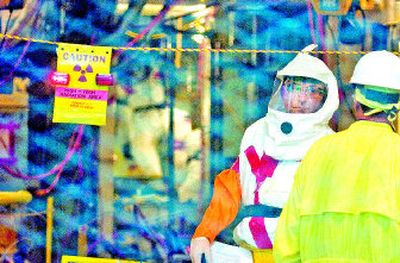Nuclear waste in limbo

RICHLAND – As the Pacific Northwest’s only nuclear power plant unplugs Saturday to refuel its core with new uranium rods, decades-old questions about how to handle nuclear waste are on display at the Columbia Generating Station about 10 miles north of Richland.
Outside the nuclear power plant, spent fuel rods have been encased in 15 special steel cylinders and then encased in concrete cases parked upright like small grain silos on concrete pads. These waste containers are ringed with razor-wired chain link fence and monitored by security cameras. It’s a similar scenario at dozens of other nuclear plants in 31 different states; a stopgap solution for the reactors’ radioactive waste.
The spent rods of uranium and fission byproducts such as plutonium and other materials are kept safe in these temporary tombs, even as birds and bugs fly among the containers that sit baking in the desert sun and wind, said Dale Atkinson, Energy Northwest’s vice president of nuclear generation.
It wasn’t supposed to be this way.
The containers, along with three more ready to be loaded, symbolize the political problems of nuclear plants – especially at a time when there is renewed talk of building more commercial reactors to produce electricity. Nuclear advocates hope that economic conditions and politics will dovetail and allow dozens more reactors to be added to the 104 now in operation. They see it as a way to reduce burning fossil fuels such as coal, and slow global warming.
Two issues continue to frustrate Atkinson and other nuclear plant officials: the federal government’s ban on reprocessing spent nuclear fuel, and its failure to finish building the Yucca Mountain nuclear waste dump 100 miles northwest of Las Vegas.
While nations in Europe, along with Japan, reprocess spent uranium fuel rods, the United States forbids the practice.
Atkinson said reprocessing the spent fuel rods would reduce their nuclear waste tonnage by 87 percent. What’s left from one silo more than 200 feet high could one day be compressed into a glass block the size of a tall kitchen trash can.
The reprocessing ban occurred during President Carter’s administration of the 1970s, which was concerned with nuclear weapons proliferation during the decade before the Cold War ended.
Reprocessing is associated with eventually creating weapons-grade plutonium, according to critics, including the Union of Concerned Scientists. The risk of nuclear terrorism is too great, they contend. Perhaps the more pressing problem is that there’s no place to permanently store large amounts of radioactive waste.
Energy Northwest, formerly known as the Washington Public Power Supply System (WPPSS), claims it has paid the federal government more than $100 million – toward development of the Yucca Mountain repository.
And now, as Energy Northwest needs to begin storing its nuclear garbage, national and Nevada politics, along with scientific controversy, financial funding and cost overruns have brought work at the $70 billion Yucca Mountain dump to a standstill.
The spent rods will be radioactive for thousands of years unless scientists figure out ways to use or make the material inert.
Energy Northwest, a public power consortium of 17 public utility districts in Washington state along with the cities of Seattle, Tacoma and Richland, started the reactor in December 1984, using fission from uranium fuel rods immersed under more than 20 feet of water to heat and bring the reservoir to a boil. The water is pumped from the core, where its heat is used to produce steam, which runs conventional generators.
The spent fuel rods had been removed and stored in a separate water pool inside the reactor. But beginning in 2002 – 18 years after operations began – the company ran out of room to house the spent fuel.
Today the plant generates about 1,200 megawatts, enough electricity to serve a city the size of Seattle.
It sits on land leased from the U.S. Department of Energy’s Hanford Nuclear Reservation. Though the electricity produced at the plant is sold by the Bonneville Power Administration, a federal power marketing agency in Portland, the plant is not owned by the federal government.
It is the only success story in the WPPSS legacy of failed efforts to build five nuclear plants in the 1970s to provide electricity to the Northwest. Two other plants stand partially completed near the Columbia Station – once called No. 2.
They were abandoned in the 1980s and triggered the largest municipal bond default in history as investors lost almost $2.25 billion.
Atkinson said there are about 30 different reactor proposals under consideration. Most of those would be built in the southeast and Texas. Any chance for more nuclear power in the Pacific Northwest – with its abundance of hydropower – would be in a second round of considerations, he said.
The refueling outage starting Saturday will last 38 days but will not affect electricity users. During the outage, about 1,900 maintenance workers will work on upgrades and test equipment. Some of the plant’s equipment in the control room, for example, is analog technology from the 1970s.